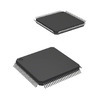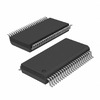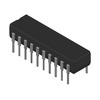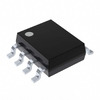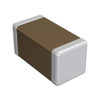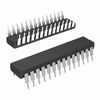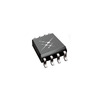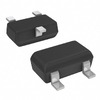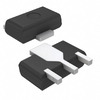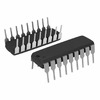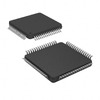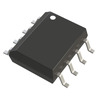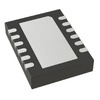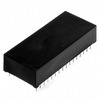Understanding the ATMEGA4809 Microcontroller: Pinout, Datasheet, and Key Functions
The ATmega4809 microcontroller, part of Microchip's megaAVR® 0-series, is a powerful tool for you seeking a balance between performance, versatility, and efficiency. Operating at frequencies up to 20 MHz, this microcontroller integrates the AVR® processor with a hardware multiplier, making it ideal for a wide range of applications from consumer electronics to industrial control systems. In this article, we will explore the ATmega4809’s pinout, key features, and advanced functionalities, highlighting why it stands out as a robust choice for both simple and complex projects.Catalog

Pinout of ATMEGA

CAD Model of ATMEGA
Symbol

Footprint

ATmega4809 Overview
As a distinguished member of the megaAVR® 0-series, the ATmega4809 stands out by incorporating an AVR® processor with a hardware multiplier that can operate at frequencies up to 20 MHz. This microcontroller is available in various configurations, featuring up to 48 KB Flash memory, 6 KB SRAM, and 256 bytes of EEPROM within 28- to 48-pin packages. Its design centers on a flexible, low-power architecture that integrates sophisticated features such as the Event System, SleepWalking, accurate analog functionalities, and state-of-the-art peripherals, reflecting Microchip's latest innovations.
Architecture and Performance
• AVR Processor and Hardware Multiplier: Equipped with an AVR® processor complemented by a hardware multiplier, the ATmega4809 delivers notable computational efficiency and performance. Running at speeds up to 20 MHz, this duo enhances execution speed for complex mathematical operations. Such capabilities make the microcontroller well-suited for applications demanding high precision and rapid processing. The design appeals to those striving to strike a balance between power consumption and performance, offering a harmonious fit for various technical needs.
•Memory Configurations: With its flexible memory options, the ATmega4809 provides configurations of up to 48 KB Flash memory, 6 KB SRAM, and 256 bytes EEPROM. This adaptability caters to a wide range of application needs, from simple tasks requiring minimal memory to more complex applications needing substantial storage. Real-world scenarios show that a balanced memory setup can significantly enhance system performance and responsiveness.
Low-Power Features
• Event System: The Event System of the ATmega4809 allows direct peripheral-to-peripheral communication, eliminating the need for CPU intervention. This feature lowers power consumption and boosts efficiency by allowing tasks to be completed with minimal CPU wake-ups. By reducing CPU load, it extends battery life in portable devices and improves overall system efficiency. This design philosophy emphasizes a blend of performance and energy conservation, resonating with applications that prioritize low-energy use.
• SleepWalking Technology: SleepWalking technology enables peripherals to operate independently while the CPU remains in a low-power sleep mode. This capability ensures major tasks are executed with minimal power draw, optimizing the device's longevity and operational efficiency. Experiences from various implementations highlight the importance of such power-saving techniques in applications where energy efficiency is prime.
Analog Capabilities
The ATmega4809 boasts precise analog functionality, featuring Analog-to-Digital Converters (ADC), Digital-to-Analog Converters (DAC), and Comparators. These analog peripherals provide accurate analog signal processing, used in applications involving sensor data acquisition, audio signal processing, and other scenarios where precise analog measurements are required. Practical uses frequently demonstrate that maintaining high analog accuracy is basic for achieving reliable and consistent system performance.
Peripherals and Expandability
Endowed with advanced peripherals, the ATmega4809 supports a wide array of applications. These peripherals extend the microcontroller's capabilities with interfaces for communication protocols, timers, and pulse-width modulation (PWM). Such a comprehensive peripheral set enables the ATmega4809 to adapt to diverse and complex designs, fostering innovative solutions through its flexibility and expandability.
Detailed Specifications
Here is the technical specification table for the Microchip Technology ATMEGA4809-AFR.
|
Type |
Parameter |
|
Factory
Lead Time |
13
Weeks |
|
Mounting
Type |
Surface
Mount |
|
Package
/ Case |
48-TQFP
Exposed Pad |
|
Surface
Mount |
YES |
|
Data
Converters |
A/D
16x10b |
|
Number
of I/Os |
41 |
|
ROM
(word) |
24,576 |
|
Operating
Temperature |
-40°C
to 125°C TA |
|
Packaging |
Tape
& Reel (TR) |
|
Series |
megaAVR®
0 |
|
Part
Status |
Active |
|
Moisture
Sensitivity Level (MSL) |
3
(168 Hours) |
|
Number
of Terminations |
48 |
|
HTS
Code |
8542.31.00.01 |
|
Terminal
Position |
QUAD |
|
Terminal
Form |
GULLWING |
|
Supply
Voltage |
3V |
|
Terminal
Pitch |
0.5mm |
|
Base
Part Number |
ATMEGA4809 |
|
JESD-30
Code |
S-PQFP-G48 |
|
Supply
Voltage-Max (Vsup) |
5.5V |
|
Supply
Voltage-Min (Vsup) |
1.8V |
|
Oscillator
Type |
Internal |
|
Speed |
20MHz |
|
RAM
Size |
6K x
8 |
|
Voltage
- Supply (Vcc/Vdd) |
1.8V
to 5.5V |
|
uPs/uCs/Peripheral
ICs Type |
MICROCONTROLLER,
RISC |
|
Core
Processor |
AVR |
|
Peripherals |
Brown-out
Detect/Reset, POR, PWM, WDT |
|
Clock
Frequency |
20MHz |
|
Program
Memory Type |
FLASH |
|
Core
Size |
8-Bit |
|
Program
Memory Size |
48KB
(48K x 8) |
|
Connectivity |
I2C,
SPI, UART/USART |
|
Bit
Size |
16 |
|
Has
ADC |
YES |
|
DMA
Channels |
NO |
|
PWM
Channels |
NO |
|
DAC
Channels |
NO |
|
EEPROM
Size |
256
x 8 |
|
On-Chip
Program ROM Width |
16 |
|
Boundary
Scan |
NO |
|
Format |
FIXED-POINT |
|
Integrated
Cache |
NO |
|
RAM
(words) |
512 |
|
Number
of Serial I/Os |
4 |
|
Number
of Timers |
5 |
|
Number
of External Interrupts |
41 |
|
On-Chip
Data RAM Width |
16 |
|
Length |
7mm |
|
Height
Seated (Max) |
1.2mm |
|
Width |
7mm |
|
RoHS
Status |
ROHS3
Compliant |
Block Diagram of ATMEGA4809

ATMEGA4809 Characteristics
Enhanced Hardware Multiplier for Swift Calculations
The ATMEGA4809 boasts a high-performance hardware multiplier that accelerates arithmetic operations immensely. This is mostly advantageous for applications involving intensive mathematical processing, thereby enhancing computing efficiency. Examples include cryptography, signal processing, and actual data analysis, where the hardware multiplier can significantly reduce processing time, optimizing system performance.
Three Sleep Modes for Optimized Power Management
The microcontroller supports three sleep modes.
• Idle Mode: Retains CPU activity while reducing power to peripherals, ideal for scenarios that demand quick response times.
• Standby Mode: Conserves more energy by halting the CPU and maintaining useful operational states, fitting for applications with periodic activity.
• Power Down Mode: Offers maximum power savings by stopping all activities, suitable for battery-powered devices with sporadic usage.
Event System for Peripheral Coordination Without CPU Burden
A notable attribute is the Event System, enabling peripherals to interact directly without CPU involvement. This reduces latency and bolsters overall system responsiveness by offloading peripheral coordination. Such a mechanism is invaluable in actual control systems where timing and precision are active. The Event System's architecture, similar to direct memory access techniques, minimizes CPU bottlenecks, enhancing efficiency.
Watchdog Timer (WDT) for System Stability
The integrated Watchdog Timer bolsters system reliability by monitoring and recovering from operational hiccups. The WDT acts as a failsafe mechanism, resetting the microcontroller upon detecting non-responsiveness, thereby averting system crashes. This layer of reliability is mostly used in industrial control systems and consumer electronics, ensuring enhanced security and stability.
Power-On Reset (POR) and Brown-Out Detection (BOD) for Consistent Operation
For safe startup and reliable operation, the ATMEGA4809 includes.
• Power-On Reset (POR): Initiates the microcontroller upon power restoration, ensuring a consistent startup state.
• Brown-Out Detection (BOD): Protects against voltage fluctuations that might compromise device stability, automatically resetting the system when voltage drops below a set threshold.
Single-Pin Programming and Debugging Interface (UPDI) for Efficient Development
The Single-Pin Unified Program Debug Interface (UPDI) significantly eases development and debugging processes. This interface reduces the physical and procedural complexities generally associated with microcontroller programming and debugging, enhancing developer productivity. UPDI's simplicity is mostly beneficial in iterative development cycles, where rapid testing and debugging are major for timely project completion.
In essence, the ATMEGA4809's attributes furnish a versatile and efficient platform suitable for a wide array of applications, including consumer electronics and industrial automation. By integrating advanced power management, rapid computation capabilities, and robust reliability features, it provides a formidable foundation for developing high-performance, reliable systems.
Circuit ATMEGA4809

Comparison of ATMEGA4809 and ATMEGA328
Performance and Efficiency Comparison
Both the ATMEGA4809 and ATMEGA328 deliver comparable levels of performance. The ATmega328, commonly found in Arduino boards, stands out in power efficiency. This microcontroller integrates ATMEL's PicoPower Technology, enabling lower power consumption without sacrificing performance.
Architectural Differences
Examining the architectures more closely, the ATmega4809 provides certain enhancements over the ATmega328. The ATmega4809 offers a flexible peripheral configuration system. This flexibility provides better overall system performance. The system is more adaptable, especially in applications involving multiple sensors or peripherals.
Programming and Development
In terms of programming and development, the backward compatibility of the ATmega4809 with the ATmega328 is advantageous. This compatibility simplifies the migration process of existing projects originally designed for the ATmega328. Advanced debugging tools supported by the ATmega4809 can be highly beneficial in complex projects, allowing for early issue identification and resolution.
Power Consumption in Practical Applications
The power consumption differences become mostly evident in actual applications. For battery-powered devices, the ATmega328's PicoPower capabilities can extend operational periods between charges. The ATmega4809's advanced power-saving features can optimize energy use further, especially beneficial in ultra-low-power applications.
Future-Proofing and Versatility
Considering future-proofing, the ATmega4809's many enhanced functionalities render it a more versatile option. Its broader support for peripherals and improved memory management are active for complex, evolving applications. These features provide a robust foundation for future innovations and expansions, making it ideal for planning upgrades.
Package of ATMEGA4809


Manufacturer Information
Microchip Technology Inc., based in Chandler, Arizona, excels in offering a broad range of microcontrollers and analog semiconductors. This company is renowned for reducing development risks, cutting down system costs, and speeding up time-to-market. Through their high-quality support and dependable products, Microchip has firmly established its leadership in the industry.
The ATMEGA4809 stands out among Microchip's offerings due to its advanced capabilities and adaptable architecture, making it suitable for diverse applications requiring robust and efficient solutions. This microcontroller supports a broad array of functionalities, making it effortlessly integrate into various systems.
Datasheet PDF
ATMEGA4809-AFR Datasheets:
Frequently Asked Questions [FAQ]
1. What is ATMEGA4809?
The Atmega4809 is a sophisticated microcontroller that utilizes the 8-bit AVR® processor. This advanced hardware comes with an integrated multiplier and operates at speeds up to 20 MHz. It offers a substantial 48 KB of Flash memory, 6 KB of SRAM, and includes 256 bytes of EEPROM, all neatly housed within a 48-pin package. With its robust design, it caters to a variety of intricate applications and commands.
2. What can the ATMEGA4809 be used for?
The Microchip Technology ATmega4809 8-bit Microcontroller is planned to optimize highly responsive command and control applications. It significantly enhances the functionality of actual control systems. Its versatile nature allows it to be utilized in comprehensive microprocessor-based architectures or as independent processors within command-and-control frameworks. Utilizing this microcontroller can elevate the performance of diverse projects.
3. How does the ATMEGA4809 improve real-time applications?
The ATmega4809 addresses the increasing requirements for speed and efficiency in actual systems. The hardware multiplier and the high operating frequency (up to 20 MHz) enable rapid processing and quick response times. These benefits applications requiring immediate feedback and precise control, such as robotics and automation systems. By incorporating the ATmega4809, you can meet the demanding needs of actual applications.
4. Are there any additional features that enhance the usability of the ATMEGA4809?
Indeed, the ATmega4809 is equipped with numerous peripheral features that augment its usability. These include multiple communication interfaces like UART, SPI, and I2C, which facilitate seamless integration with other digital devices. In addition, it boasts robust analog features, including ADCs and DACs, making it highly suitable for sensor interfacing and analog signal processing. These features combine to make the ATmega4809 a versatile tool for a wide range of digital and analog tasks.
5. How does ATMEGA4809 compare with other microcontrollers in its class?
When compared to other microcontrollers in its class, the ATmega4809 stands out due to its balanced combination of memory capacity, processing speed, and peripheral integrations. Its 8-bit architecture, complemented by efficient power management features, makes it an optimal choice for applications where power consumption is a serious factor. This balance ensures it delivers reliable performance without compromising on efficiency.
6. Can the ATMEGA4809 be used in educational projects?
The ATmega4809 serves as an excellent platform for educational purposes. Its straightforward architecture and comprehensive documentation make it suitable for learning and experimentation. By engaging with this microcontroller, you can gain valuable insights into embedded systems development, command, and control logic, as well as actual system design. The ATmega4809 creates a hands-on environment for you to explore and innovate.
About us
ALLELCO LIMITED
Read more
Quick inquiry
Please send an inquiry, we will respond immediately.

BAV199 Low Leakage Diode: 85V 140mA SOT323 with Datasheet and Features
on October 11th

VL53L1X Laser-Ranging Sensor: Specifications, Pinout and Circuit Diagram
on October 11th
Popular Posts
-

Understanding Power Supply Voltages in Electronics VCC, VDD, VEE, VSS, and GND
on June 13th 24175
-

USB-C Pinout and Features
on June 13th 21286
-

The Ultimate Guide to Wire Color Codes in Modern Electrical Systems
on January 1th 17465
-

TL494 Current-Mode PWM Controller IC
on January 1th 14733
-

Current Divider Circuits and Effective Use of the Divider Formula
on January 1th 13630
-

FET (Field Effect Transistor) Circuit Symbols
Field-Effect Transistors (FETs) are widely used in modern electronics and are found in everything from simple devices to complex digital systems. To work with these transistors effectively, it's helpful to understand the symbols that represent different types of FETs. These symbols do more than just show what the transistors look like—they also provide information about how each transistor works ...on January 1th 13440
-

Quality (Q) Factor: Equations and Applications
The quality factor, or 'Q', is important when checking how well inductors and resonators work in electronic systems that use radio frequencies (RF). 'Q' measures how well a circuit minimizes energy loss and impacts the range of frequencies the system can handle around its main frequency. In systems with inductors, capacitors, and tuned circuits, a higher 'Q' means the circuit focuses more on a spe...on January 1th 13393
-

Understanding and Building Op-Amp Based Peak Detectors
In the world of electronic circuit design, peak detectors are key tools for accurately analyzing and processing signal strengths. These circuits are designed to find and keep the highest signal amplitude, making sure the peak value is precisely captured and held as needed. Peak detectors are important in many fields, from improving audio quality in communication systems to aiding medical diagnoses...on June 13th 12497
-

LM741 Op-Amp: Features, Specifications, and Applications
The LM741 op-amp is a popular and flexible electronic component. This article goes over the pin layout, functions, specs, and different ways the LM741 can be used, while also comparing it to similar models like the LM358.Catalog1. What Is the LM741 Op-Amp?2. The LM741 Pin Configuration3. The LM741 Pin Functions4. Specifications of the LM7415. Features of LM7416. LM741 Circuit Applications7. LM741 ...on June 13th 12034
-

ST-LINK/V2: Pinout, Specifications, and Datasheet
This article takes you through the ST-LINK/V2, a well-regarded tool that amplifies connectivity and functionality. Key topics will cover its pinout configuration, delve into its 3D model, and spotlight specifications. Such understanding expands the horizons of STM microcontrollers in diverse applications. By grasping these interfaces and tools, you can transform embedded systems, opening doors to ...on January 1th 11579

